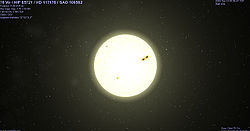70 Virginis
| Observation data Epoch J2000.0 Equinox J2000.0 | |
|---|---|
| Constellation | Virgo |
| Right ascension | 13h 28m 25.8086s[1] |
| Declination | +13° 46′ 43.638″[1] |
| Apparent magnitude (V) | +4.97[2] |
| Characteristics | |
| Spectral type | G4 V-IV[3] |
| U−B color index | 0.26 |
| B−V color index | 0.714±0.007[2] |
| V−R color index | 0.39 |
| R−I color index | 0.36 |
| Variable type | none |
| Absolute magnitude (MV) | +3.70±0.01[4] |
| Details | |
Gyr | |
| Database references | |
Exoplanet Archive | data |
| ARICNS | data |
70 Virginis is a binary
This object has a
In 2011, a star was discovered 2.86 arcseconds away from the primary, and is likely associated with 70 Virginis. Based on its properties, it has a spectral type later than M5V, and has a mass of about 8% that of the Sun.[10] There is also an L-type brown dwarf 42.7 arcseconds away from the primary, but it is unclear whether this is bound to the system.[10]
In 1996, 70 Virginis was discovered to have an
Planetary system
The discovery of the planet around 70 Virginis was announced on January 17, 1996 at the meeting of the American Astronomical Society in San Antonio, Texas. The planet was detected using radial velocity measurements taken with the C. Donald Shane telescope at Lick Observatory. It has an orbital period of 117 days, an eccentricity of 0.4, and a mass at least 7.4 times that of Jupiter.[14][12]
| Companion (in order from star) |
Mass | Semimajor axis (AU) |
Orbital period (days) |
Eccentricity | Inclination | Radius |
|---|---|---|---|---|---|---|
| b | >7.40±0.02 MJ | 0.481±0.003 | 116.6926±0.0014 | 0.399±0.002 | — | — |
| Dust disc | >3.4 AU | — | — | |||
References
- ^ S2CID 244398875. Gaia DR3 record for this source at VizieR.
- ^ S2CID 119257644.
- ^ S2CID 119244142.
- ^ Holmberg; et al. (2009). "HD 117176". Geneva-Copenhagen Survey of Solar neighbourhood III. Retrieved 2010-02-02.
- ^ S2CID 119226823
- ^ S2CID 18370219. (web Preprint)
- ^ S2CID 14911430, 40. See Table 3.
- ^ S2CID 43455849.
- ^ "70 Vir". SIMBAD. Centre de données astronomiques de Strasbourg. Retrieved 2023-11-25.
- ^ .
- S2CID 2603568.
- ^ S2CID 9528214.
- S2CID 54940779.
- ^ Sanders, Robert (January 17, 1996). "Discovery of two new planets -- the second and third within the last three months -- proves they aren't rare in our galaxy" (Press release). University of California, Berkeley. Retrieved December 22, 2017.
- S2CID 42414832.
External links
- Jean Schneider (2011). "Notes for star 70 Vir". Extrasolar Planets Encyclopaedia. Archived from the original on April 7, 2010. Retrieved 10 October 2011.
- SolStation: 70 Virginis

